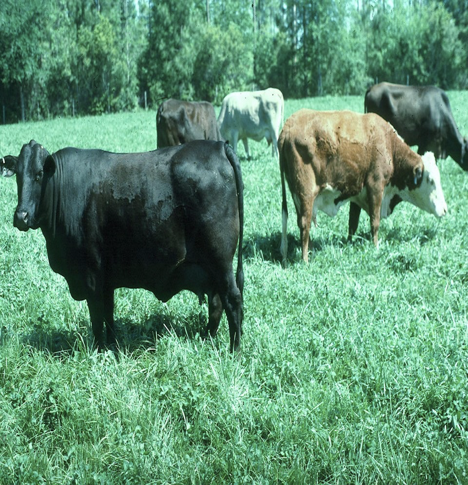
The most expensive aspect of raising livestock is providing feed for them. In general, pasture forage is less expensive than hay or other stored feed, including hay. Here is a concise review of the major options for reducing stored feed.
Use Cool Season and Warm Season Forages
On some farms in the Upper South and mid-South, it is possible to grow both cool season perennial forages such as tall fescue or orchardgrass and warm season perennials such as bermudagrass, dallisgrass, or sericea lespedeza. In the lower South where cool season perennials are not widely adapted, bahiagrass and bermudagrass dominate pasture acreage.
However, cool season annual forages including annual ryegrass, small grains, and annual clovers can be used to great advantage to increase the number of calendar days of grazing. Overseeding such annuals on warm season perennial grass sods is especially widely practiced. Warm season annuals including annual lespedeza, crabgrass, various sorghums, and pearl millet can make important contributions as well, especially in the Upper South where cool season perennial forages dominate pasture acreage.
The native grasses, switchgrass, indiangrass, eastern gamagrass, big bluestem, and little bluestem require more establishment precision and a higher level of grazing management than most pasture forages. Nonetheless, they can provide a great deal of forage during hot, dry periods, which is particularly valuable in areas in which cool season forages are dominant.
Variety Selection
In some cases, varieties within a species differ significantly with regard to distribution of growth. This potentially offers a producer the opportunity to “fill in gaps” in pasture forage availability. In most cases variety decisions should not be based solely on distribution of growth, but it is worth considering when two or more varieties are otherwise about equally acceptable are being considered.
Stockpiling Forage
“Stockpiling” is the technique of allowing forage to accumulate to allow grazing it at a later time. Forage of many different crops can be stockpiled, but it works especially well with tall fescue because it holds its quality well. This simply involves clipping and fertilizing a fescue field in early autumn (normally with at least 40 pounds of nitrogen per acre as well as with any other nutrients needed) and then deferring grazing until the time hay would otherwise need to be fed. Allowing the animals to only have access to a few days supply of grazing at a time is the efficient way to utilize the forage. Stockpiling can often delay the feeding of hay for several weeks or even months.
Graze Crop Residues
Livestock can utilize the residues remaining from any of several summer row crops after the crop has been harvested. While the fodder of such crops is of low nutritive value, in some cases there may be substantial quantities of grain available that help increase the energy value of the material present. Even if only a few weeks of nutrition is provided for animals when a row crop field is grazed, it will help reduce wintering expenses.
Timing of Fertilization
Fertilizer can be used as a management tool to optimize production when good growing conditions exist, and to increase forage production just before times when slow plant growth is expected. Thus, application of fertilizer (especially nitrogen-containing fertilizer) can shift the timing of availability of pasture forage, although it is contingent upon adequate moisture being available for plant growth.
Grazing Management
When pastures are grazed appropriately for the forage species they contain, the plants will be healthier and more productive over a longer period of time. If pastures are grazed too closely, depletion of food reserves reduces the food-producing capacity of plants. Some forage crops are much more sensitive to this than others.
Good grazing management can also reduce forage waste. If pastures are undergrazed (which often occurs with poorly managed, continuously stocked areas), losses due to trampling and fouling of forage can be substantial. Limit grazing, strip grazing, or rotational stocking can reduce these losses, often resulting in utilization of 20 to 30 percent more of the forage produced, thus lengthening the grazing period.
Minimizing Hay Losses
Poor hay storage and feeding practices cause many producers to need to produce or purchase much more hay (sometimes more than twice as much) than they would otherwise need. Numerous approaches can be used to lower hay losses, some of which cost little to implement.
__________________
Foraging Ahead is a column presented by Ragan & Massey and written by Dr. Don Ball, Professor Emeritus at Auburn University. Dr. Ball is one of the authors of the popular book “Southern Forages,” which can be found via a computer search that uses the words, “Southern Forages, The Fertilizer Institute.”
